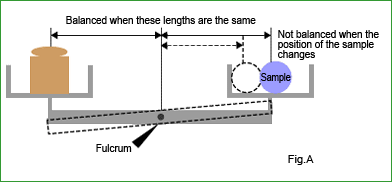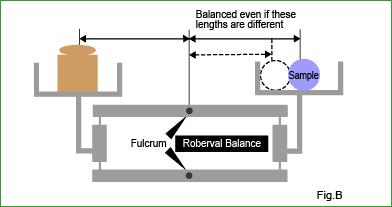Roberval Balance
The Roberval Balance is used in Shimadzu top-loading electronic balances such as the top-loading BX/BW series and analytical AW/AX/AY series.
The Roberval Balance is a mechanism invented by the 17th century French mathematician Gilles Personne de Roberval. The sample position on the pan does not affect the weight measurement. The following describes the mechanism of this Roberval Balance, which should be called the basic principle of top-loading balances.
What Would Happen If the Roberval Balance Did Not Exist?
With the balance in Fig. A, pans are fixed in place on the beam. By the principle of leverage, balances of this structure require the length from the fulcrum to the weight and the length up to the sample to be the same. If the position where the sample is placed on a pan is changed, as shown by the dotted line in the figure, this balance becomes out-of-balance even if the placed sample is the same. This means that this mechanism cannot be used as a balance since the balance point shifts depending on where the sample is placed.

For This Reason
The Roberval Balance has a parallelogram frame structure with freely moving sides, as shown in Fig. B. If pans are placed on its vertical beams and the sample and weight are placed on top of these pans, they will be balanced regardless of where the sample and weight are placed if their masses are the same. The sample may be placed anywhere on the pan.

This is the basic structure of the Roberval Balance. In Shimadzu top-loading electronic balances, further improvements have been made to this basic structure to achieve superior accuracy (i.e. little eccentric error).






